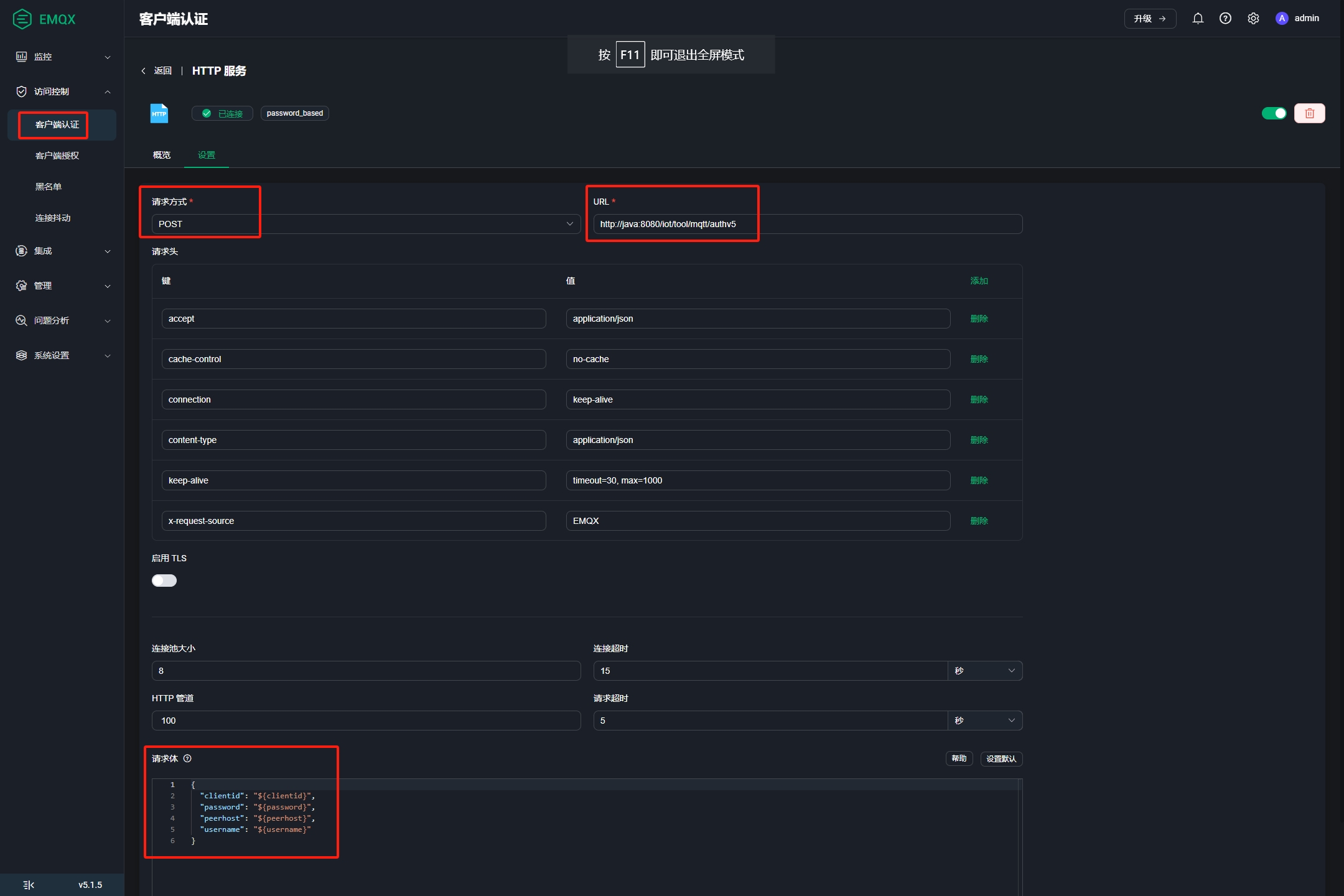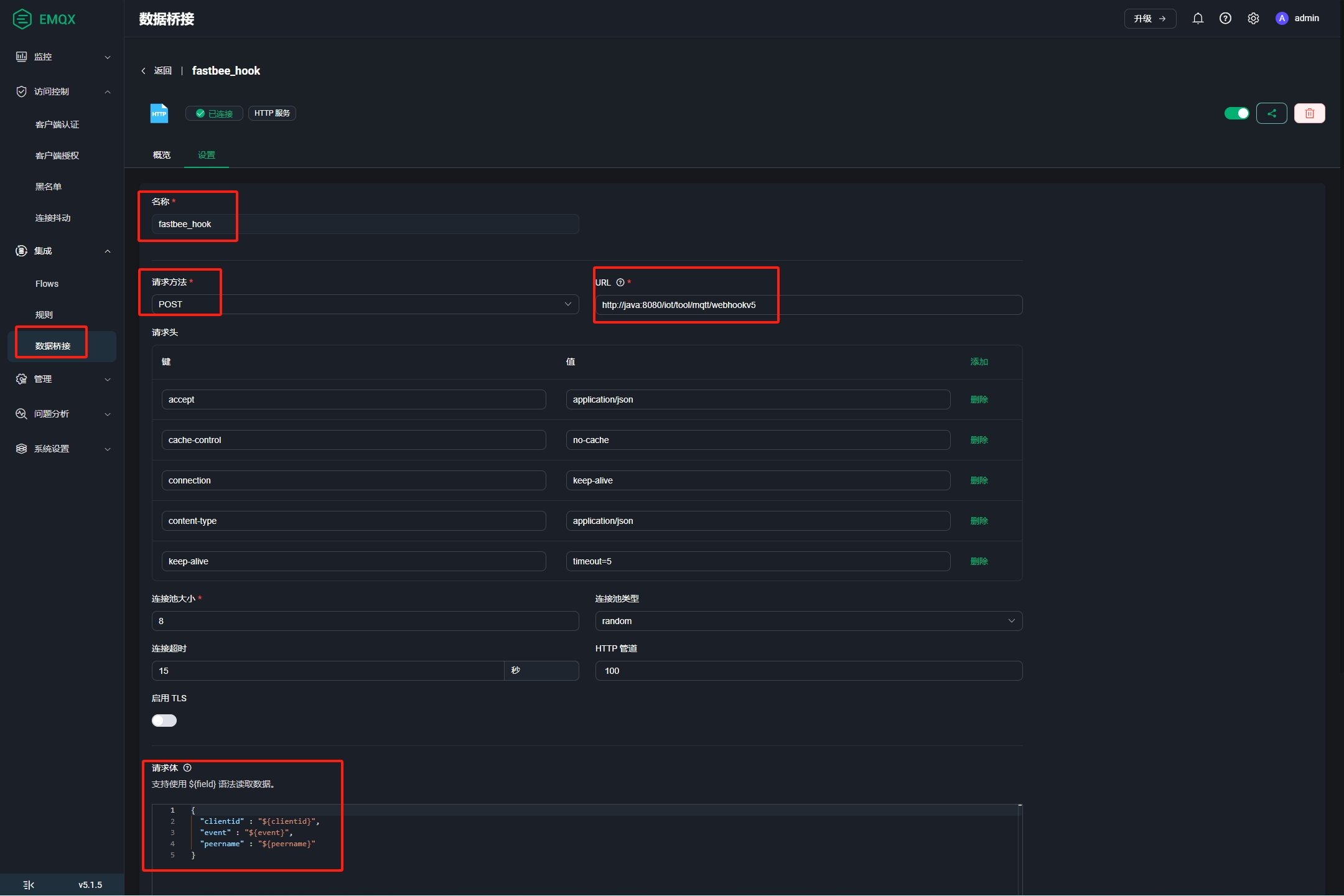 使用Emqx5
使用Emqx5
# 一、Docker安装Emqx5
docker run \
--name emqx \
--publish 1883:1883 \
--publish 8083:8083 \
--publish 8883:8883 \
--publish 8084:8084 \
--publish 18083:18083 \
--env TimeZone=Asia/Shanghai \
--volume /etc/localtime:/etc/localtime \
--restart unless-stopped \
--detach \
emqx:5.1
1
2
3
4
5
6
7
8
9
10
11
12
2
3
4
5
6
7
8
9
10
11
12
# 二、Emqx5配置
Emqx配置Http认证和Webhook(处理客户端上下线),有两种方式:
- 通过emqx.conf文件配置,已有配置好的文件位于
docker/data/emqx/ect文件夹; - 通过18083端口,打开Emqx控制台,创建客户端认证,数据桥接和规则
- 通过emqx.conf文件配置,已有配置好的文件位于
Emqx账号
- 控制台默认账号 (admin,public)
- docker-compose方式部署,emqx.conf中配置的账号(admin,admin123)
注意
Emqx控制台修改的账号,配置的Http认证、Webhook和规则会被emqx.conf中对应配置覆盖掉。官网解释如下:
- 通过 Dashboard、HTTP API 或 CLI 进行的更改将在运行时写入 data/configs/cluster.hocon 文件并立即生效。
- 如果相同的配置项在 etc/emqx.conf 文件中设置不同值,则在重新启动后,最终生效的是 etc/emqx.conf 中的配置。 为避免混淆,强烈建议不要在 cluster.hocon 和 emqx.conf 中具有相同的配置键。
emqx.conf配置文件中存在任何规则,设备消息转发的规则,也要配置在emqx.conf中。
# 配置文件方式
下面内容复制到emqx.conf文件中
# 设置控制台端口和默认账号
dashboard {
listeners.http {
bind = 18083
}
default_username = "admin"
default_password = "admin123"
}
# http 认证
authentication = [
{
mechanism = password_based
backend = http
enable = true
method = post
url = "http://177.7.0.13:8080/iot/tool/mqtt/authv5"
body {
clientid = "${clientid}"
username = "${username}"
password = "${password}"
peerhost = "${peerhost}"
}
headers {
"Content-Type" = "application/json"
"X-Request-Source" = "EMQX"
}
}
]
# WebHook(匹配上线和下线规则后触发)
bridges {
webhook.延凡科技_hook =
{
enable = true
connect_timeout = 15s
retry_interval = 60s
pool_type = random
pool_size = 8
enable_pipelining = 100
max_retries = 2
request_timeout = 15s
method = post
url = "http://177.7.0.13:8080/iot/tool/mqtt/webhookv5"
body = "{\"clientid\" : \"${clientid}\",\"event\" : \"${event}\",\"peername\" : \"${peername}\"}"
headers = { accept = "application/json" "cache-control" = "no-cache" connection = "keep-alive" "content-type" = "application/json" "keep-alive" = "timeout=5"}
}
}
# 规则(处理上线和下线)
rule_engine {
ignore_sys_message = true
jq_function_default_timeout = 10s
rules.延凡科技_rule =
{
sql = "SELECT * FROM \"t/#\",\"$events/client_connected\", \"$events/client_disconnected\", \"$events/session_subscribed\""
actions = ["webhook:延凡科技_hook"]
enable = true
description = "处理设备上下线和订阅完主题的规则"
}
}
1
2
3
4
5
6
7
8
9
10
11
12
13
14
15
16
17
18
19
20
21
22
23
24
25
26
27
28
29
30
31
32
33
34
35
36
37
38
39
40
41
42
43
44
45
46
47
48
49
50
51
52
53
54
55
56
57
58
59
60
61
2
3
4
5
6
7
8
9
10
11
12
13
14
15
16
17
18
19
20
21
22
23
24
25
26
27
28
29
30
31
32
33
34
35
36
37
38
39
40
41
42
43
44
45
46
47
48
49
50
51
52
53
54
55
56
57
58
59
60
61
# 控制台创建方式
- 配置Http认证

请求方式:POST
请求地址:http://177.7.0.13:8080/iot/tool/mqtt/authv5 (地址可以是内网或者外网,确保能访问)
请求Body:
{
"clientid": "${clientid}",
"password": "${password}",
"username": "${username}",
"peerhost": "${peerhost}"
}
1
2
3
4
5
6
7
8
9
10
11
2
3
4
5
6
7
8
9
10
11
- 配置WebHook
Webhook配置,先创建数据桥接,然后创建规则,规则跟数据桥接关联

数据桥接名称:延凡科技_hook (随意填写)
请求方式:POST
请求地址:http://177.7.0.13:8080/iot/tool/mqtt/webhookv5 (地址可以是内网或者外网,确保能访问)
请求Body:
{"clientid" : "${clientid}", "event" : "${event}", "peername" : "${peername}"}
1
2
3
4
5
6
7
8
2
3
4
5
6
7
8

规则名称:延凡科技_rule (随意填写)
SQL编辑器内容(分别代表客户端连接/断开连接/主题订阅完成):
SELECT * FROM "t/#","$events/client_connected", "$events/client_disconnected", "$events/session_subscribed"
动作:选择创建的数据桥接延凡科技_hook
1
2
3
4
5
6
2
3
4
5
6